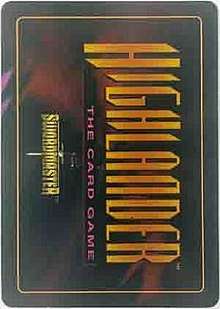Highlander: The Card Game
Highlander: The Card Game is an out-of-print collectible card game based on the Highlander franchise of films and television series.[1][2] Players build decks from a 400+ card set, taking on the persona of one of the Immortals depicted in the franchise. The core of the game takes the form of a sword duel with players alternately playing attacks and defenses. Other cards are played to affect the basic rules of the game. You win when your opponent is reduced to 0 ability or cannot avoid a "headshot" attack (i.e. decapitation, the only way to permanently kill an Immortal within the franchise canon). An expansion called the Movie Edition was released in mid March of 1996.[3]
 The card back to Highlander: The Card Game | |
| Designer(s) | Mike Sager |
|---|---|
| Publisher(s) | La Montagnard Inc., SAEC Games, Thunder Castle Games |
| Players | 2 (or more in some variations) |
| Playing time | Approx 20 min |
| Random chance | Some |
| Skill(s) required | Card playing Arithmetic Basic Reading Ability |
Card types
Basic attacks
Nine attacks, one to each space on the attack grid.
Basic blocks
Six blocks, four each covering four areas of the attack grid, two covering just the upper and lower rows.
Guards
Defense cards which can stay in play multiple turns, but must be discarded if the player wishes to attack.
Special cards
- Events: happen once and are discarded.
- Edges: modify other cards they are played with; not considered "Special Cards" for game play purposes, multiple Edges may be played in a single turn.
- Situations: stay in play and change the basic rules of the game.
- Locations: like situations, but only one location can be in play at once.
- Allies: introduced in later expansions, earlier they were treated as situations.
- Illusions: introduced in later expansions; not considered "Special Cards" for game play purposes, and may only be played from an exertion.
- Plots: formerly a subset of Situations and Events in older versions, these also stay in play and change the basic rules of the game, often adding up for a greater effect.
Pregame cards
- Persona cards: rare cards featuring established characters from the films and television series, allowing players to use persona-specific cards, or enhancing the abilities of standard persona cards. Most personas also grant a special ability to the player, such as dealing extra damage per attack or granting extra attacks per turn.[4]
- Quickenings: rewards for winning tournaments and sponsored events, granting abilities to the user similar to those of certain personas.
- Weapon of Choice: allow players to use special weapon-specific cards.
- Watcher: affects the basic rules of the game.
Reception
According to Terry Elder, that game had a strong following on the east coast of the United States, central midwest, and in California.[5]
References
- Miller, John Jackson (2003), Scrye Collectible Card Game Checklist & Price Guide, Second Edition, pp. 225–232.
- Owens, Thomas S.; Helmer, Diana Star (1996), Inside Collectible Card Games, p. 55.
- Varney, Allen (May 1996), "Reports on Trading Card Games", The Duelist (#10), p. 9
- "The 10 Most Forgotten Collectible Card Games". therobotsvoice.com. Retrieved 2017-12-28.
- Varney, Allen (September 1996), "Inside the Industry - Reports on Trading Card Games", The Duelist (#12), p. 73